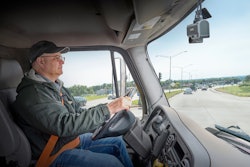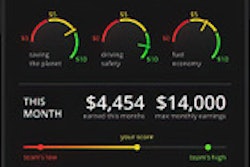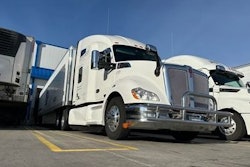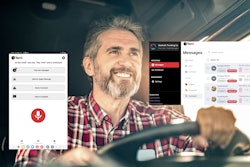
How do fleets keep their drivers engaged and loyal? Find out in this webinar.
Invest in drivers and they’ll invest in you. Join us for a live webinar on Thursday, Sept. 26 at 1 p.m. Central to cover proven ways to keep drivers engaged and loyal, including enhanced driver feedback options, improved route planning, equipment spec’ing and innovative pay models.
In this webinar, sponsored by Netradyne, you'll hear from A. Duie Pyle, Cargo Transporters and PS Logistics on how they have made their businesses successful.
NAPA Transportation implemented driver-facing dash cameras in 2016. Over the years, drivers’ initial reticence waned as they began to understand why the cameras were there, but it seemed to be a grudging acceptance, said Safety Director Joe Salisbury. Then in 2021, when the carrier made moves to update the technology, leadership was struck by drivers’ reactions, as if it were the first-ever implementation.
“We were having to go back to square one and convince them all over again,” Salisbury said.
He said drivers were giving him the same old tired speech about how they didn’t need “big brother” watching them.
Lytx Vice President of Global Sales Strategy Jeff Martin said communication with drivers about the camera system is key to getting them onboard. "Explain what it is, what is isn't and why it's being deployed," he said. "At the end of the day, it starts and finishes with, first and foremost, protecting the assets – and that's all the individuals in that cab."
Driver-facing dash cameras are becoming more common, but many fleets continue to experience backlash from drivers when implementing the technology because of privacy concerns.
Mark Murrell, president of Carriers Edge, a provider of online driver training for the trucking industry, said it isn’t so much about privacy as it is perception.
He said while driver-facing cameras are lagging, the majority of fleets now have road-facing cameras. Companies experienced the same criticism of those, too, when they first came out.
“Drivers didn't want anybody watching the road or watching what was happening, but then, all of a sudden, we started seeing all of these dashcam videos showing up on YouTube, and it became a way for drivers to share the crazy stuff they were dealing with on a day-to-day basis,” Murrell said. “Then we started seeing more and more stories about how the camera footage had exonerated drivers in crashes, and it was becoming kind of a safeguard and all of a sudden the driver perspective changed completely.”
He said there’s a lot of miscommunication and misunderstanding of how driver-facing cameras work; drivers’ perception is that these cameras are a means for their companies to “spy on them” like a Peeping Tom.
And it’s the fleet’s duty to change driver perception of what the camera does and why it’s there.
"Statistically speaking, (video technology) is saving lives," Martin said. "It's reducing frequency and, certainly, severity."
Coach, don’t discipline
Garner Trucking has had driver-facing cameras for nearly three years. COO Tim Chrulski said it’s all about the approach.
Before installation, Garner spent a lot of time talking with drivers, helping them understand the intent: safety education and exoneration in the event of an accident.
He said there was a lot of company messaging published across different formats as well as town halls to educate everyone about the coming cameras.
“You've got to communicate well in advance that this is the situation, and here's the reasons why, here's the motivation, and here's the choice we've made in the service provider to protect your privacy,” Chrulski said. “I was very concerned with a lot of the things that you hear from other carriers that have opposition, but we were able to reduce those to minimal concerns or worries just by addressing things on the front end.”
Murrell said companies should start with a small pilot or proof of concept to get drivers on their side before expanding it to the rest of the fleet.
“Those companies always do well and always have a much better success rate,” he said.
That’s what Boyle Transportation did. Vice president of Safety Mike Lasko agreed with Chrulski that getting the initial rollout right is crucial. Boyle started with five to 10 trucks driven by its “all-star” drivers, Lasko said, and the pilot went well.
Lasko, who started his career in trucking as a professional driver, said when the company he drove for implemented driver cameras, the mentality behind it was to catch a driver doing something and make an example of them so everyone else snaps in line.
“That's the most counterproductive strategy, and you end up losing a lot of good drivers,” he said. “When you when you roll out cameras to your fleet, I promise you it's not going to be super popular, so it's really important that you highlight to the drivers why you’re getting the cameras and what you expect the cameras to do, and that you don't use the cameras as a weapon.”
He said his goal with cameras is to provide a measure of protection for his drivers and the company because of the epidemic of nuclear verdicts and lawsuit abuse that the industry has become exposed to.
Murrell said companies that position cameras to “catch the bad apples” end up building a management versus drivers culture, resulting in rejection and a lot of accidentally broken cameras.
Garner doesn’t use its cameras to terminate drivers. Instead, if there is an incident or accident, safety brings drivers in individually to watch their video, and it’s used as a coaching opportunity to learn what could have been done to prevent it.
“We didn't lose anybody over cameras,” Chrulski said. “If you are looking to put these in your trucks to have a gotcha moment, that's a bad plan. It has to be about education; it has to be about vindication. It has to be about the things that it really is intended for, and that is to train the driver to do better tomorrow than they did today. It's about having that opportunity to be able to show what actually happened in a scenario and help exonerate the organization and the driver from undue harm and blame. Everybody always wants to blame the big truck for everything, and we've certainly seen several videos that show it wasn't actually the carrier.”
Lasko said another way to get drivers on board is to celebrate the wins when a driver is exonerated and to gamify with incentives around driver risk scores.
A different angle
When Garner installed cameras, Chrulski had its provider position the camera so that it only points at the driver seat so there is no driver concern that they’re being watched during their personal time in the sleeper berth.
In addition, the system the carrier uses does not record when the vehicle isn’t in motion, and it only records if an event triggers it. Drivers can also hit a button to start a recording if they run into a situation on the road that warrants it. They can also input a code that shuts the camera system down once the truck is parked for extra peace of mind. He said that helps his drivers feel like they’re more in control.
Murrell said trigger-based camera systems are a much easier sell to drivers. But Barrett Young, chief marketing officer at Netradyne, said that means a fleet is only getting a portion of the story.
Though Netradyne’s system doesn’t record when the vehicle is parked, and it offers a privacy mode that fleets can elect to use, its camera runs constantly, analyzing 100% of drive time, because it improves the system’s accuracy.
“With trigger-based, every time you talk to your driver, it's about something negative. So that relationship with the drivers and the fleet managers or safety managers obviously becomes contentious over time,” Young said. “So we are actually the only system that has the ability to recognize positive driving so that you can see all the great things the driver is doing in addition to the things that need to be improved.”
Netradyne’s system gives driver stars for positive behavior like maintaining a safe distance, following the speed limit, etc., like Lasko suggested.
Lasko said Boyle doesn’t use driver-facing cameras in its over-the-road operation because 40% of their drivers are women. The company only uses driver-facing cameras in its local operations. The company instead uses other telematics data to detect things like hard braking and speeding, for example.
That’s what many fleets using Driver Technologies opt to do as well.
COO and Co-founder Marcus Newbury said Driver Technologies works with several fleets that don’t want or need the interior camera footage and instead are content simply understanding when their drivers are distracted or drowsy. The Driver Technologies platform provides its customers with telematics data without video footage, though it also offers a video option.
“Based on our experience, fleet drivers’ main concerns are that they feel they are under a microscope and that their employer is violating their privacy. Thankfully, there is mobility technology today that doesn’t require consistent video monitoring to encourage safe driving behavior,” Newbury said. “Most commonly, fleet owners prefer to implement our commercial fleet solution with telematics and exterior video only to ensure they have footage available to provide if they need to file an insurance claim. I would advise fleet owners to be transparent if they collect data via a driver’s dashcam and tell their employees what they plan to do with their data.”
Data privacy
Being watched isn’t the only worry drivers may have. Murrell said a rising concern is how their data is being stored and used.
“As more and more jurisdictions increase their legislation around privacy, internet usage and data collection and things like that, things that weren't really considered personal or private a few years ago are now considered to be that,” Murrell said. “In some places, pretty much anything that might affect somebody's job prospects is considered private information or personal data.”
Footage of a driver eating or texting while driving, for example could have the potential to influence their job prospects down the road, he said, so those kinds of things are becoming private data.
Murrell said the trucking industry historically hasn’t given much thought to data privacy of its driver employees, but it’s something that’s going to become more of an issue.
“If you talk to vendors of these cameras, most of them have a plan where they just automatically delete this footage after like a year or two years or something,” he added. “Protecting that so that it doesn't end up in the wrong hands, or the fleet protecting it, making sure that they don't distribute them any more widely than they absolutely need to, that's something that the industry needs to start thinking about because you could have somebody end up with some of the footage posted publicly when it really shouldn't be, and it paints them in a bad light unfairly.”
If a bad actor gets ahold of driver recordings, he said they could use the footage for public shame or embarrassment and possibly even extortion. It’s something fleets should seriously be concerned about.
“I think the larger issue is going to be somebody that already has a grudge with that fleet selectively releasing footage that makes them look dangerous, or makes them look bad, or makes it look like they're not good public citizens – that kind of thing,” Murrell said. “That can become a real issue.”
Salisbury said if drivers consider cameras an invasion of privacy, the trucking industry may not be the place for them going forward because fleets are going to continue employing driver cameras to mitigate risk.
He said drivers are performing duties in a space owned by their employer, who is the one at risk in the event of an accident.
“Drivers want to be able to be on their cell phone; drivers want to be able to not pay attention to the world around them and have other distractions and do things that are perfectly fine if you're sitting behind a stationary desk,” Salisbury said. “But at 80,000 pounds at 60 miles an hour, I would prefer that a professional driver’s focus be on controlling that vehicle at all times, not on their phone call, or their Snapchats, or their podcast, or whatever else it is they want to do out there.”














